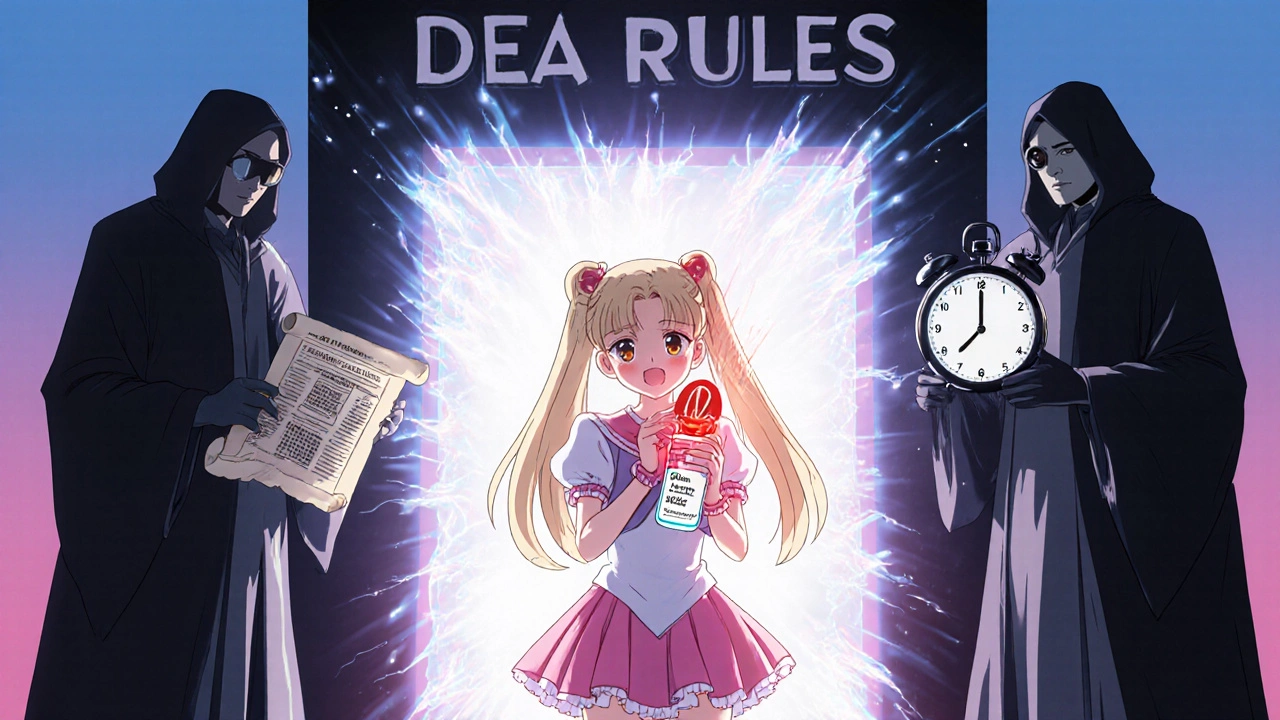When you need a refill for your generic antidepressant or blood pressure pill, you might not think twice about ordering it online after a 15-minute video call with a doctor. But behind that simple click is a complex web of federal rules, state laws, and technical barriers that are changing faster than most patients - or even doctors - realize. In 2025, telemedicine prescriptions for generic medications are more common than ever, but not all prescriptions are created equal. The difference between getting sertraline and buprenorphine online isn’t just about the drug name - it’s about whether the government considers it a controlled substance, and who’s allowed to prescribe it.
How Telemedicine Prescriptions Work Today
Telemedicine prescriptions aren’t new, but the rules around them have shifted dramatically since 2020. Before the pandemic, federal law - the Ryan Haight Act - basically banned doctors from prescribing controlled substances like opioids or ADHD meds without seeing you in person first. That rule was paused during COVID, and now, after years of extensions, it’s being rewritten.
As of November 2025, the DEA has proposed new rules that will take effect after December 31, 2025. Until then, you can still get many prescriptions online without an in-person visit. But after that date, things get stricter - and more confusing.
Here’s the basic breakdown: If your medication is not a controlled substance - like generic lisinopril, metformin, or fluoxetine - there are no federal restrictions on prescribing it via telemedicine. You can get it renewed every month, every three months, or even annually, depending on your doctor’s judgment. These are the prescriptions that make up the bulk of telehealth visits - and they’re not going anywhere.
But if your medication is controlled - like generic buprenorphine for opioid use disorder, or generic Adderall for ADHD - the rules change completely. The DEA now has three new registration categories for providers, and only certain types of doctors qualify to prescribe these drugs remotely.
Controlled vs. Non-Controlled: The Big Divide
The difference between controlled and non-controlled drugs isn’t just legal - it’s personal. For someone managing chronic pain or addiction, this distinction can mean the difference between getting treatment and going without.
Non-controlled generics are treated like any other prescription. A psychiatrist, family doctor, or even a nurse practitioner can prescribe them after a virtual visit. No special DEA registration needed. No mandatory state database checks. Just a standard electronic prescription sent to your pharmacy.
Controlled substances? That’s a different story. The DEA’s new rules split them into two groups:
- Schedule III-V drugs (like buprenorphine, tramadol, or low-dose benzodiazepines): These can be prescribed via telemedicine without an in-person visit - but only for an initial six-month supply. After that, you must either see a doctor in person or meet strict ongoing telemedicine conditions.
- Schedule II drugs (like oxycodone, Adderall, or fentanyl patches): These are almost entirely off-limits for most providers. Only specialists - board-certified psychiatrists, hospice doctors, pediatricians, neurologists, and some long-term care physicians - can prescribe them remotely. Primary care doctors, even if they’ve been treating you for years, are blocked unless they prove an "extremely compelling" case.
This creates a strange situation: A patient with depression can get generic sertraline renewed every month over video. But someone with opioid use disorder - who needs the same kind of ongoing care - can only get six months of generic buprenorphine before being forced to drive to a clinic, often hundreds of miles away.
What Providers Have to Do (And Why It’s So Hard)
It’s not just about the rules - it’s about the paperwork. To prescribe any controlled substance via telemedicine after December 2025, doctors must:
- Register with the DEA under one of the new categories (Telemedicine Prescribing, Advanced Telemedicine, or Platform Registration)
- Use electronic prescribing for controlled substances (EPCS) - no paper or fax allowed
- Check the state’s Prescription Drug Monitoring Program (PDMP) before every prescription - and log the exact time and date
- Verify the patient’s identity using a government-issued photo ID scanned during the visit
For a rural family doctor in Montana seeing patients across three states, this means checking up to three different PDMP databases before each appointment. That’s 15 to 20 extra minutes per patient - time they don’t have.
And it’s not just busywork. In the first quarter of 2025, 42% of DEA registration applications were rejected because doctors didn’t document PDMP checks correctly. Many clinics don’t have the right software. Some states don’t even have working PDMP systems that talk to each other.
One telepsychiatrist in California told Reddit users she’s had three prescriptions rejected this month - not because the patient didn’t qualify, but because the pharmacy in Nevada didn’t recognize the new federal rules. The system isn’t ready. The rules are already here.

Why Generics Are the Backbone of Digital Health
Generic medications make up over 90% of all prescriptions filled in the U.S. And in telemedicine, they’re the most reliable part of the system. They’re cheaper, more accessible, and - crucially - they’re not tangled in the same red tape as controlled substances.
For patients with high blood pressure, diabetes, or anxiety, telemedicine has made managing chronic conditions easier than ever. No more taking half a day off work to sit in a waiting room. No more driving across town just to get a refill. A quick video call, a digital signature, and the medication arrives in two days.
But the system’s success depends on keeping these non-controlled generics simple. If every refill required ID scans, state database checks, and DEA registration, telemedicine would collapse under its own weight. That’s why the rules treat them differently - and why they’re the real workhorse of digital health.
Meanwhile, controlled substances - even generic ones - are treated like weapons. The DEA’s goal is to prevent abuse. But the side effect is that people who need these medications - often those with the least access to care - are the ones most affected.
What’s Coming in Late 2025 and Beyond
By the end of 2025, the current emergency rules expire. After that, every provider prescribing controlled substances via telemedicine must be registered under the new DEA categories. The transition won’t be smooth.
Only 31 out of 127 telehealth platforms offering controlled substance prescriptions have completed the DEA’s Platform Registration. Many smaller clinics won’t bother - the cost of compliance (software, training, legal help) can be $10,000 to $25,000 per year. And Medicare is making it harder too: Starting October 1, 2025, patients must have had an in-person mental health visit before they can get reimbursed for telehealth prescriptions.
Industry experts predict a 15-20% drop in telemedicine-based controlled substance prescriptions by 2026. That’s not because demand is falling - it’s because the system is breaking under its own complexity.
The DEA has promised a national PDMP system by 2027, but that’s two years away. Until then, doctors are stuck with patchwork state databases that don’t talk to each other. And patients? They’re the ones caught in the middle.

What Patients Should Do Now
If you’re using telemedicine for a non-controlled generic - like your thyroid med or cholesterol pill - you’re in the clear. Keep using it. It’s safe, legal, and convenient.
If you’re getting a controlled substance - like buprenorphine or Adderall - here’s what to do:
- Ask your provider: "Are you registered under the new DEA telemedicine rules?" If they say no, find someone who is.
- Make sure your pharmacy knows about the new rules. Some still reject telemedicine prescriptions for controlled substances out of caution.
- Keep records of all your virtual visits. If your prescription is denied, you’ll need proof you followed the rules.
- If you live in a rural area, start planning ahead. The six-month limit means you may need to schedule an in-person visit before your supply runs out.
Don’t assume your provider knows the rules. Many don’t. The DEA’s own website says 68% of psychiatrists are overwhelmed by the new documentation requirements. You’re not alone - but you are responsible for making sure your care doesn’t get stuck in bureaucracy.
Where the System Is Working
It’s not all bad. For opioid use disorder, telemedicine has been a lifeline. SAMHSA reports that 89% of addiction treatment providers now use telemedicine for initial buprenorphine prescriptions. Patients who used to drive 80 miles for a weekly visit now get care from their kitchen table.
The Addiction Policy Forum found that 73% of patients say telemedicine improved their access to life-saving treatment. That’s real progress. But it’s fragile. If the six-month rule stays, and if primary care doctors are locked out, that progress could stall.
The real challenge isn’t technology. It’s policy. The DEA wants to stop drug abuse. But in trying to do that, they’ve created a system that makes it harder for people who need help to get it.
For now, the system works best for non-controlled generics. That’s where digital health shines - simple, fast, and safe. For controlled substances? It’s still a minefield. And until the rules catch up to reality, patients and providers will keep stumbling through it.

 Pharmacology
Pharmacology
Kathryn Ware
November 16, 2025 AT 20:33Okay but let’s be real - telemedicine for generics is the only reason I haven’t lost my mind managing my hypertension. I used to take half a day off work just to get a refill. Now? I click ‘approve’ during my lunch break and it’s at my CVS by 5 PM. No judgment, no waiting, no drama. This is what healthcare should look like in 2025. Why are we even debating this?
Eric Healy
November 17, 2025 AT 06:11u think this is progress? lol. you guys are so naive. the DEA’s rules are fine. if you need adderall you should be seen in person. its not a vitamin. its not your phone charger. its a controlled substance. you dont get to treat it like a amazon order. stop whining. its not that hard to drive somewhere. your laziness is not a public health crisis
Shannon Hale
November 17, 2025 AT 08:19OH MY GOD. I JUST HAD A PATIENT GET THEIR BUPRENORPHINE PRESCRIPTION REJECTED BECAUSE THE PHARMACY THOUGHT IT WAS ‘FRAUD’ BECAUSE THE DOCTOR WASN’T ‘VERIFIED’ IN THEIR SYSTEM. LIKE. WHAT. IS THIS. 1999? WE HAVE BLOCKCHAIN AND AI BUT STILL CAN’T GET TWO GOVERNMENT SYSTEMS TO TALK TO EACH OTHER? I’M CRYING. I’M NOT EVEN KIDDING. I’M CRYING. THIS ISN’T HEALTHCARE. THIS IS A TERRIFYING GAME OF CHAOS MONOPOLY.
Holli Yancey
November 18, 2025 AT 14:56I get both sides. I really do. My mom’s on lisinopril and she’s been getting refills via telehealth for two years now - no issues. But my cousin with OUD was forced to drive 90 miles for his six-month renewal because his provider didn’t register in time. It’s not that the rules are wrong - it’s that the infrastructure is crumbling under them. We need better tech, not more bureaucracy. And maybe a little compassion?
Gordon Mcdonough
November 19, 2025 AT 00:12AMERICA IS FALLING APART BECAUSE PEOPLE WANT THINGS TO BE EASY. WE USED TO WALK TO THE DOCTOR. WE USED TO WAIT. WE USED TO RESPECT THE SYSTEM. NOW? WE WANT A PRESCRIPTION IN 12 MINUTES WHILE WE’RE ON THE TOILET. THIS ISN’T HEALTHCARE. THIS IS A TIKTOK TRENDS. AND THE DEA IS JUST TRYING TO STOP US FROM SELF-DESTRUCTING. BUT NOBODY LISTENS. WE’RE ALL JUST LITIGIOUS, ENTITLED, PHONE-ADDICTED ZOMBIES.
Jessica Healey
November 20, 2025 AT 21:36my therapist literally cried when she told me she couldn’t prescribe my generic adderall anymore because her software doesn’t support the new PDMP sync. she’s been doing telehealth for 10 years. she’s one of the best. and now? she’s quitting. not because she doesn’t care - because the system is designed to break people like her. we’re not fighting over drugs. we’re fighting over whether we still care about people who need help.